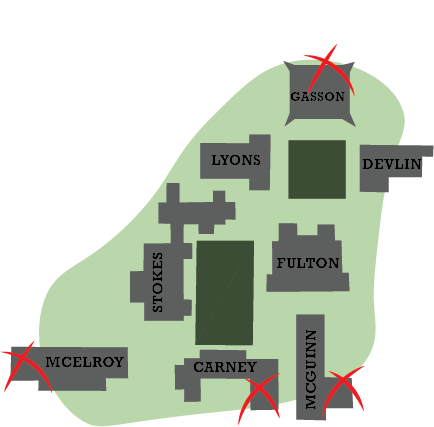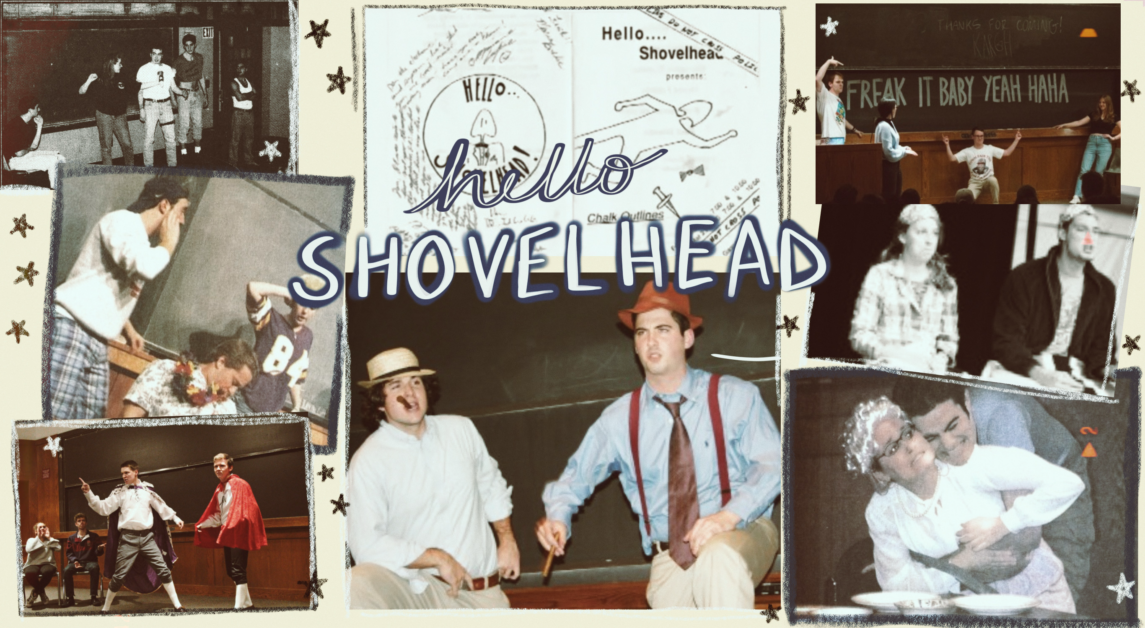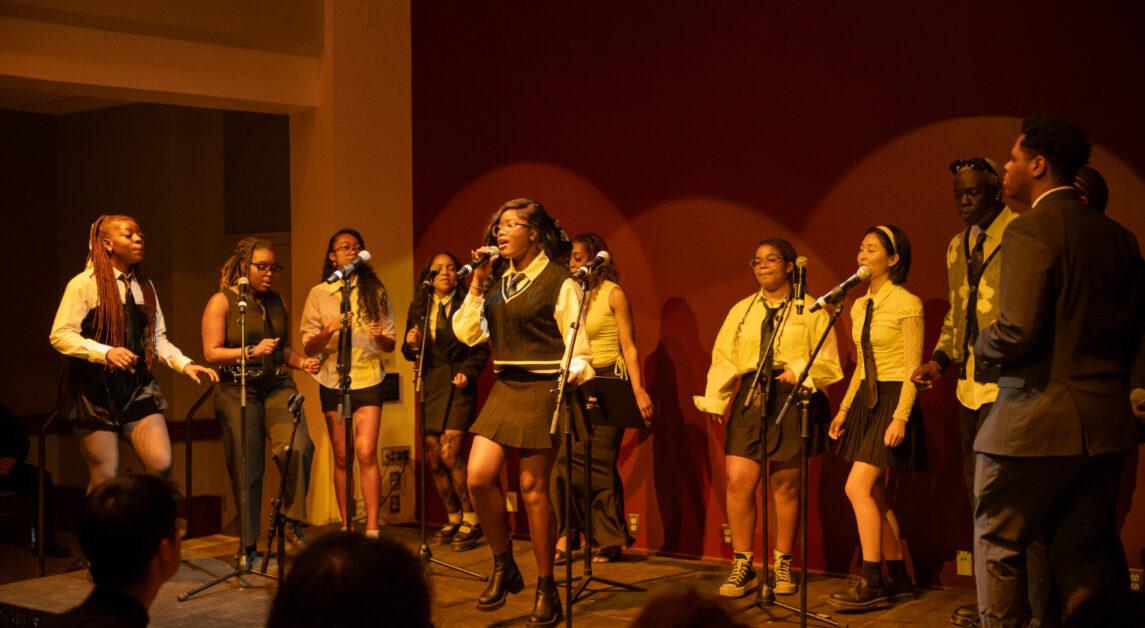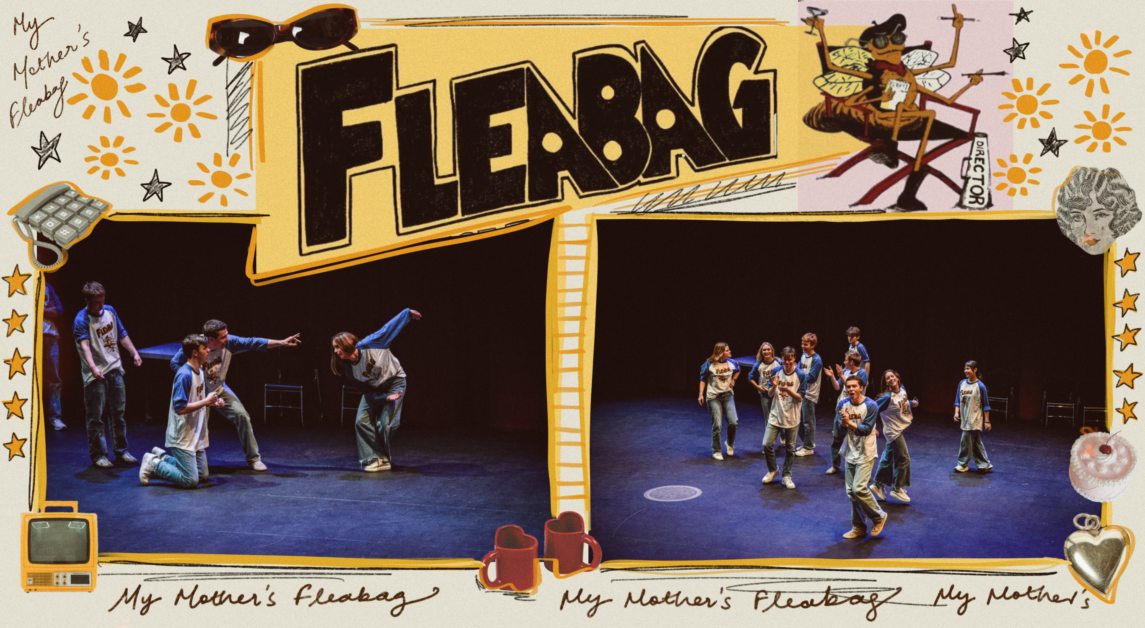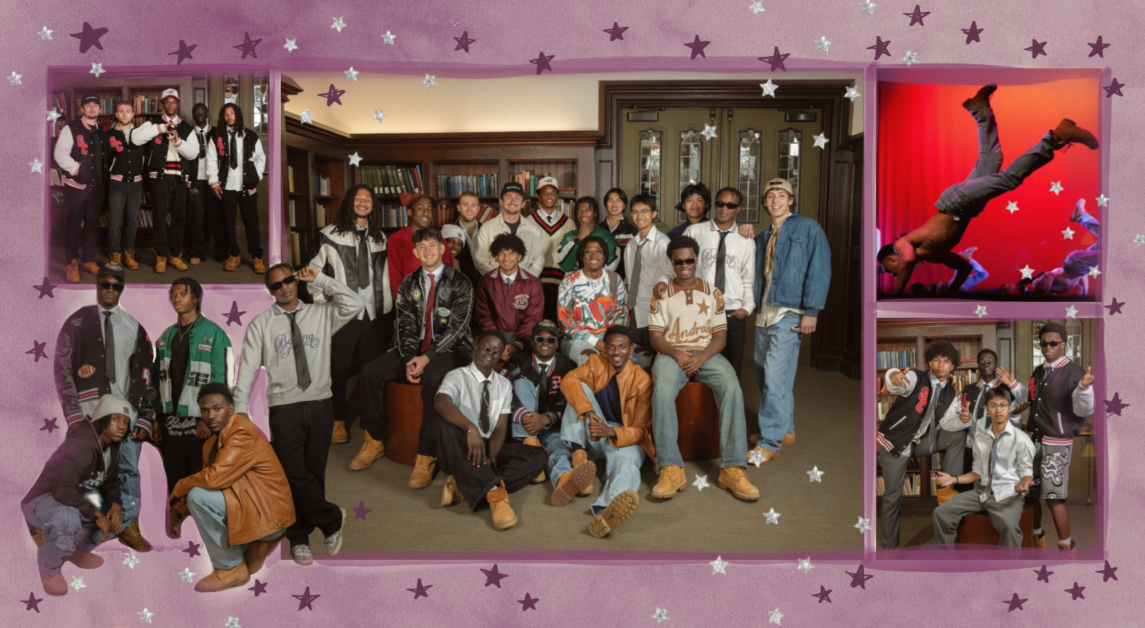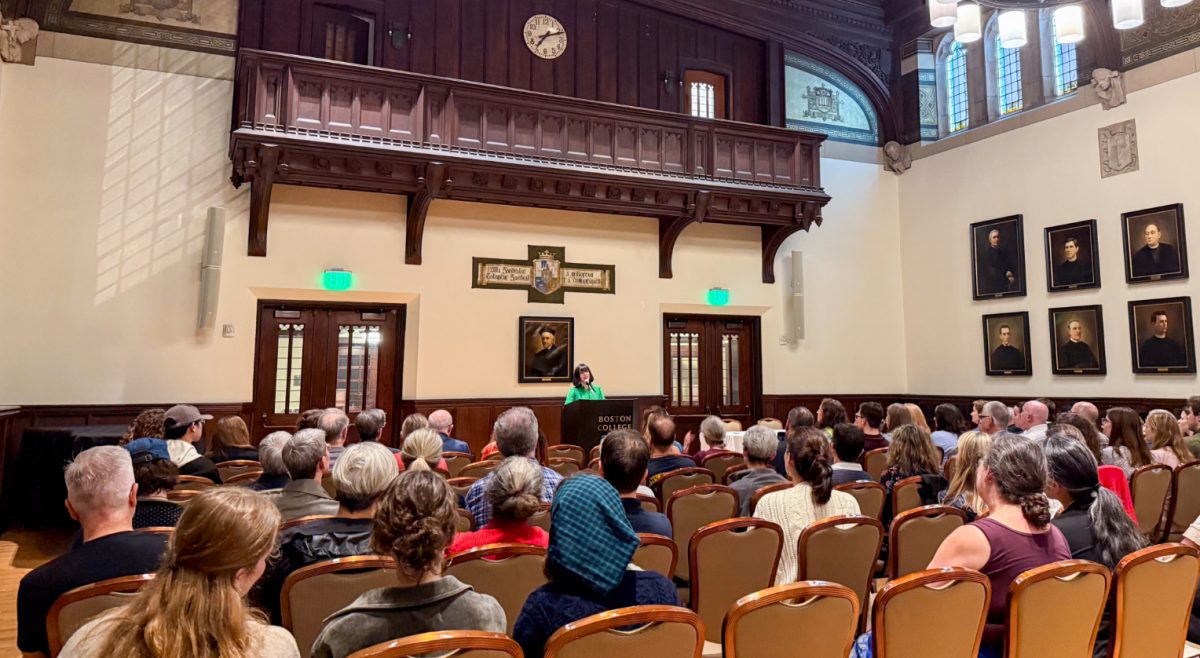Spring has begun and Showdown looms. The biggest dance competition of the year has been scheduled a month earlier than usual and Presenting Africa to You (PATU) is doing all that they can to prepare their performance. To do this, PATU decided to have much longer practices than usual. Brighton Dance Studio, O’Connell House, and the Plex Multipurpose Rooms had been booked long before, and there is no availability in sight.
PATU managed to find space in Gasson 100 to serve as a late-night practice venue. The night was long, and midnight was fast approaching. While running through the group’s Cleopatra-focused performance, a member of the staff interrupted to ask if they were going to be there late. The members desperately needed the space and the time, and said that they would be. The staff member left them to their practice, just asking them to put the chairs back in their places and turn the lights off when they left.
Moments later, after the team had just begun to dance again, a member of the cleaning crew again appeared. He told them that he needed to clean the rooms and that they would have to leave the building for the night. At such an hour, all other spaces were either occupied or closed. PATU couldn’t complete its rehearsal that night.
This was not the first time the team had been told to leave a space because the building was closing up. Two years before, PATU was similarly rehearsing its Showdown performance. This time, the team was using the dance studio in O’Connell House. A few hours into the practice, PATU members were told that the studio would be closing. It was 10 minutes to midnight, so under the watchful eye of the staff member, the dancers squeezed out one more routine. After all, every moment counts when it comes to Showdown.
Stories like this aren’t unique to PATU. Many other dance groups at Boston College have been through similar situations, often before big performances or competitions. Conspiracy Theory hosts an annual competition in November, along with a few other dance groups. In years past, while trying to prepare itself for a show as big as this, the team books extra practices. These extra practices can’t be booked in the usual places, like O’Connell or the Plex Multipurpose rooms. Conspiracy Theory usually ends up rehearsing in the squash courts. The rooms are claustrophobic for a team of 15 active members. Conspiracy Theory’s style of dance is practiced with more peace of mind in a large open space. Breakdancing is not an activity someone wants to be doing when they run into a wall, or another person. Kevin Huang, president of Conspiracy Theory and CSOM ’19, describes the spaces succinctly:
“They suck.”
These mad scrambles for time and space to practice before big shows are common to nearly all dance groups on campus. BC has few dedicated spaces for dance teams to practice. The only ones meant solely for dance are in Brighton Dance Studio (BDS) and O’Connell House. These spaces are not large or plentiful enough for the 16 major teams on campus to share. To work around this issue, a number of rooms and spaces across campus are available for reservation on a yearly basis by dance teams and a cappella groups. These spaces are McElroy 208, the Plex Multipurpose Rooms, and Carney 206. The room in Carney is a recent addition to the available spaces for performance groups. It was cleared of chairs and tables, and mirrors have been put up on the walls. Aside from these rooms, there are a number of random spots throughout campus that can sometimes be reserved on a more spontaneous basis. These include rooms like McElroy 237; Gasson 100 and 201; McGuinn 300 and 500, as well as a few others. These rooms are not always available because they are often used for on-campus events, lectures, meetings, or classes, and must be reserved from week to week.
These spaces are allocated to each dance group, a cappella group, and any other performance group on campus by the Office of Student Involvement (OSI). Karl Bell, assistant director of student organizations, oversees this process and works closely with the heads of each group.
“Student organizations request, and are granted, space based on their (historical pattern of) needs,” Bell said in an email. “Where there are challenges with the resources (time, location, dates, etc.) organizations are asked to work closely with OSI.”
The system, however, can be exploited. Huang explained that a dance team who books early could make the tight squeeze for space even tighter.
“It’s first-come first-serve, which might lead to some unfairness with dance teams,” Huang said. “They say ‘Since no one else has already booked any of these spaces, we are gonna take all the best spaces for ourselves even if we aren’t gonna use them.’”
OSI, and the other dance teams, try their best to make sure that this doesn’t happen. Everyone is aware that the other teams are in the same spot, and that they must work together to make the best of a bad situation. Bell recognizes the challenges that the current system presents, and that all involved must make sacrifices.
“Some organizations will need to understand that it may be necessary to reduce their access to resources to provide for other organizations,” Bell said in an email. “This will not be easy, but it is absolutely necessary.”
Normally, the 16 dance groups at BC can make the space situation work. Each team practices three to four times a week, for about three hours. Spread across the weeknights and weekends, these available spaces can usually stretch enough to serve the needs of all teams simultaneously. These challenges with resources which Bell mentioned present themselves during crunch times like the weeks leading up to Showdown. At times like these, every dance team at BC is trying to practice every night of the week, for four or five hours at a time. There is greater demand for space, slower turnover of rooms, and the same meager supply to be doled out by OSI.
What makes these times, and the practice space situation in general, more difficult, are the varied needs of each team.
Each team has a different number of members and practices a different style of dance. A team like BC Dance Ensemble (DE) has 28 people showing up to each practice. DE’s size prohibits it from using smaller rooms like McElroy 208 for its practices. A group like Sexual Chocolate, however, only has 17 members, and can be more flexible in its practice space bookings.

But DE could not use some of these rooms even if it wanted, or could fit. The type of dance that they perform necessitates a very specific type of flooring: marley flooring. Marley flooring is the black mat-like substance that covers the main room in BDS. No other space on campus has this kind of floor, and so DE has to practice in just one spot, every time. Flooring is an issue for other teams in other spaces as well. BC On Tap cannot use tile flooring, out of concerns for safety, and can therefore only practice in BDS or on the wood floors of O’Connell House.
The other rooms used mainly for dance team practice like McElroy 208, Carney 206, and the Plex Multipurpose Rooms are all tiled floor which, while sometimes dirty, are usually serviceable for most other dance teams. The late-notice classrooms that dance groups book in a pinch are mostly carpet, a surface teams try to avoid at all costs.
MASTI, BC’s South Asian dance troupe, is usually forced to move around between classrooms in McGuinn, Stokes, and Carney. If it was able to choose its practice space, BDS would be at the top of the list due to its large size and wall-to-wall mirrors. MASTI is usually unable to find spaces with mirrors. The mirrored spaces on campus are BDS, Carney 206, McElroy 208, and the Plex Multipurpose rooms. Team captains Alyssa Craparotta, MCAS ’19, and Elaine Hartono, LSOE ’19, explained that they have had to come up with a tedious solution. Without available mirrors, the captains have begun setting up phones or cameras to record the entire practice session. They then upload these videos to YouTube and comment their advice and criticisms below. This can work, but the extra hour or two the captains must spend watching and critiquing each and every member of the team after every late-evening practice takes it toll.
“Without mirrors, it’s just a disaster,” Craparotta said. “When we have a mirror, everyone looks at themselves and corrects as they go.”
The a cappella groups don’t have it much easier. They may not need as big of a floor space, but they do need a quiet room to practice. Most of the teams need some semblance of a sound system in order to correctly hear the music they need to perform, and some teams like the Common Tones need a piano in the room they use. Aoyi Yang, co-president of the Common Tones and LSOE ’18, explained that the piano situation creates an additional obstacle that her team is forced to navigate.
“It’s just hard sometimes to work with OSI, the whole booking system is kind of outdated,” Yang said. “It doesn’t indicate which rooms have pianos, sometimes they [OSI] don’t even know.”
But dance groups have a better case for prioritization over a cappella groups—they need an open area in which to move. A cappella teams end up drawing the short straw because of this. Faith Rapley, co-president of the BC Sharps and MCAS ’18, discussed the group’s struggle to find a practice space at all. The group gets one practice per week in Gasson, but for the other two practices, it’s left with no choice but a dorm. The Sharps usually choose the lounge in Gabelli Hall, but practicing in dorms comes with its own set of challenges. Only seniors or residents of 66 Commonwealth Ave. can swipe into Gabelli, so other members of the team must stand outside and wait for an open door. If the Sharps get any noise complaints from people who live there, its captains said, they will be barred from using the space anymore. Rapley explained that the approval process for Gabelli lounges is different than the usual OSI booking, and is often frustrating and confusing to use. Once, the Sharps could not get approval from the RD of Gabelli. Instead of rehearsing in the lounge, the Sharps crowded into Rapley’s own dorm room in Gabelli to practice.
There have been efforts made to alleviate some of the practice space pressure. The aforementioned conversion of Carney 206 to a usable space has made things much easier for the dance groups. According to Bell, the positive attitudes and flexibility have been very helpful in this difficult situation as well. All dance groups understand that there is no easy solution to this problem. Some teams have been very receptive to practicing in spaces that aren’t usually used for dance like the various classrooms across Middle Campus, as long as the spaces also meet their needs.
But aside from these small solutions, the problem still persists. The dance teams and OSI alike recognize that this situation is far from ideal, and that it makes the lives of performance organizations like dance or a cappella much more difficult. Bell outlines the extent of the issue.
“We are making (near) maximum use of all of our available resources,” Bell said in an email. “I am not aware of any additional resources that will be available in the short term.”
The performance groups seem to flourish in spite of these difficulties. As evidenced by Showdown last year, each team was able to prepare an entertaining and often meaningful performance. Throughout the year, these dance teams display incredible talent in their individual shows. Bell, and to a greater extent OSI, are very proud and pleased with everything the groups have been able to accomplish.
“While our challenges are great, we are blessed to have a performance community that achieves extraordinary results,” Bell said in an email. “I am confident that, even in the face of limited resources, student organizations will continue to live up to the Boston College motto.”
And excel they do. This year’s performances have been and will likely continue to be even better than last year. What remains to be seen is whether this practice space problem is preventing them from achieving something even greater.
Featured Image by Meg Dolan / Heights Editor

